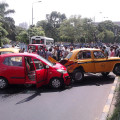
Getting places in the digital age should be easy no matter what country you are in, right?
Let’s say you want to go visit a new western pizza place that just opened in your city. You check out the website and find the address:
32 Krishna Street, 100 Foot Road, Koramangala, BangaloreYou look it up on Google Maps, just to get a rough idea of where it is. Then, to be smart, you write out the name of the pizza place, along with “32 Krishna Street, 100 Foot Road”. You head out to your nearest auto driver, give him the address, sit back, and enjoy the ride.
Not likely. You have set yourself up for a stressful trip that is not likely to end with pizza.
4 Ways You Should Not Give Directions in India
1.) Handing the address to the driver. Giving the driver a slip of paper with your intended address is not going to get you anywhere. Due to the chaotic and complex nature of India’s roads, most drivers are only familiar with larger street names. Also, nearly every small area will have an “MG Road” (Mahatma Gandhi), or a “100 Foot Road”, so these street names are not helpful for a driver without giving him the name of the area first. This strategy will only work if you are going to an extremely well-known place.
2.) Using Google Maps alone. Google maps and other GPS enabled mapping devices are great for giving you an idea of where you are going, but they cannot keep up the pace with India. Shop placements are only recently starting to become accurate. Routes are improving, but you just cannot consistently plan around bandhs, parades, and diversions. Also, just because Google says a road exists, doesn’t mean it is passable. Having a general picture of where you are going is very useful, but do not rely only on it.
3.) Walking down a road to find the door number. Door/plot numbers are not usually sequential in India. If you start walking down Krishna Street and see a place marked “26”, you might think that you just need to walk a little further and will find 32 on the same side of the road. Actually, right after 26 will come 47, and then 14/2, and then 101C. There is a method to this madness, but understanding it will not help you at all. You can mostly consider the door number worthless.
4.) Handing a map to a driver. Maybe you bought a handy city map to help you get around the city. That’s great – for you. I spent the first four months in India clutching a map in my hands as I peered out of the auto to learn the streets. However, map-reading skills are not universal. This does not reflect on the intelligence of the driver. It’s just not the way he gets around. Still, he will not want to lose face and will look intently at the map to figure out what in the world it says.
3 Ways You Will Never Get Lost:
Learn Landmarks: A landmark is a well-known site that everyone knows how to get to. Is there a famous temple nearby, a large bus stand, or a well-established shopping mall? Perhaps a government office, a statue, or the house of someone famous? When one Indian is explaining directions to another, he will always start with a common landmark. Once you establish the landmark, say it is either opposite to, next to, just past, etc. If you are going to a new place, ask them on the phone what is the nearest landmark.
Be careful that you use their landmarks instead of yours. Papa Johns and the Hard Rock Café may seem like obvious choices to you, but a driver may have no idea what you are talking about. He uses the local cinema or passport office to describe those areas.
Crowd-source: When in doubt, you can always rely on the original GPS system, which is stopping and asking someone for directions. Nearly every person you see on the road will be happy to provide you with directions. Your driver can go to the general area, and then ask a few other auto drivers for specifics in finding Krishna Street. It will not at all hurt the pride of your driver to ask him to pull over and ask someone.
I was once coming home at night from a part of town I was very unfamiliar with. My phone was dead, and I had only a vague idea where was I was going. However, I was able to stop every few kilometers and check with the chaiwallahs and auto drivers to see if I was headed in the right direction. I definitely took the long way, but I was never worried the whole time.
Warning: Should you choose to crowd-source your directions, remember to stop early and often. Some people will give directions, even if they are not sure how to get there, so you should double-check everything. Using landmarks will greatly increase the accuracy.
Bring a number: Always travel with the phone number of a new destination. Some offices or roads are so obscure that even local auto drivers won’t know where it is. To solve this, call up the number of where you are going and hand the phone immediately to the driver. Do not try to introduce the call by saying, Hello, this is [your name], do you remember me? Well, we got on the road and tried to find that temple tank you had mentioned… This is only going to confuse things. Stay out of the call as much as you can.
Learn the tricks to getting around in India, and you will never be lost; it just may take some time to get there.
A new communication series is coming next! Be sure to subscribe to stay up on the latest articles!
Photo Credit: photoshades on Flickr





This has been a great blog series on transportation in India. It’s the kind of information that could be compiled in an easily read book.